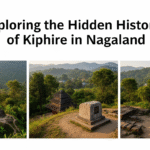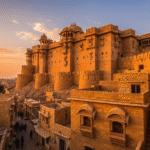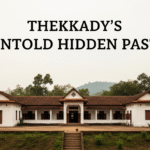Did you know Nalanda University in Bihar was a big deal long ago? It drew learners from all over the world during the Gupta era. This is just a peek into Bihar’s deep history and cultural importance. The state has many unknown temples and sacred spots. These are perfect for those who love to explore Bihar temple exploration and Bihar temple tourism.
Bihar has old temples cut from rock around the 3rd century BC. It also has holy monasteries in beautiful nature. This guide will show you Bihar’s secret temples. You’ll get tips to make your visit better. Whether you love history, are looking for spiritual places, or just like to travel, Bihar’s hidden spots are worth a visit.
Key Takeaways
- Nalanda University was important globally for learning back in the Gupta period.
- The Mahabodhi Temple Complex is protected by UNESCO.
- The Takht Sri Harmandir Sahib Ji is where Guru Gobind Singh was born.
- Old rock-cut temples and monasteries give unique spiritual trips.
- Exploring Bihar’s temples shows its rich history, deep spirituality, and natural beauty.
To find out about the best places in Bihar, like the Maha Bodhi Temple and Valmiki Tiger Reserve, see this full guide.
The Allure of Hidden Temples in Bihar
The ancient temples in Bihar draw in many with their mystery. They sit quietly among green hills and calm landscapes. These temples tell the story of Bihar’s rich history.
History and Significance
The Mundeshwari Temple is very old and important in Bihar. It was first built in the 6th century by the Gupta Empire. Now, its look comes from the 10th or 11th century.
This temple is different because it has eight sides. The Archaeological Survey of India says it’s the oldest Hindu temple in India. It has a special area for worship and idols of Lord Shiva and Devi Mundeshwari.
People go there to pray and feel blessed. They believe it brings them good fortune and health. The temple is very busy during festivals like Ramnavami and Shivratri.
Cultural Influence
Bihar’s hidden temples show its deep culture. The Mundeshwari Temple has affected culture and religion for many years. Both Buddhist and Hindu pilgrims visit, showing its spiritual importance.
Despite challenges, the temple remains undamaged. It shows the strength and importance of Bihar’s culture. These temples let us see and feel ancient traditions. They influence not just religion, but also local customs, food, and art.
Sonbhandar Caves: Rajgir’s Ancient Marvel
The Sonbhandar Caves are old wonders from the 3rd or 4th century. They sit in Rajgir district. Rich in history, these caves mesmerize both historians and travelers.
Architectural Details
The Sonbhandar Caves reflect the Mauryan period’s design. The main cave is a big rectangle with a sharp top. It shows how skilled ancient Indian builders were.
Historical Context
These caves are more than just pretty. They might hold secrets about buried treasures in their writings. Rajgir, once the Magadh empire’s heart, adds depth to these sites. The caves link India’s grand past to its cultural wealth.
Near the Sonbhandar Caves, there’s a lot more to see. Hills, sanctuaries, and paths are nearby. With 299 places to explore within 300 kilometers, adventure awaits.
Dungeshwari Hills: A Spiritual Retreat
Dungeshwari Hills lies near Sujata village. It’s famous for its history and stunning views. The Mahakala Cave there is key to Bihar’s spiritual experience.
The Penance of Buddha
The Mahakala Cave is where Buddha prepared for enlightenment. It has life-sized statues of Buddha. These show his time of deep fasting. The site was opened by the 14th Dalai Lama. It’s a must-see for exploring Bihar’s spiritual experience. There’s an ancient plaque from the 8th-9th century too.
Scenic Beauty and Trekking
Dungeshwari Hills is beautiful and serene. Getting to Mahakala Cave takes 5 to 10 minutes. The trek is short but lovely. Nearby, a new temple complex adds to the peace. This spot is perfect for both the devout and explorers. It’s a chance to see Bihar’s spiritual side and hidden spots.
| Key Highlights | Details |
|---|---|
| Sujata Stupa | Constructed in the 2nd century BCE, excavated by the Archaeological Survey of India |
| Travel Time from Bodh Gaya | Approximately 20 minutes by rickshaw |
| Mahakala Cave Inauguration | Inaugurated by the 14th Dalai Lama |
| Pathway to Mahakala Cave | 5 to 10 minutes trek |
Barabar Caves: The Oldest Rock-Cut Temples
The Barabar Caves are the oldest rock-cut temples in India. They date back to the Maurya Empire (322–185 BCE). Found in the Makhdumpur region of Jehanabad district, they are 60 km from Patna, Bihar. These caves show the amazing art and religion of that time. They are key to understanding ancient temples in Bihar and its religious history.
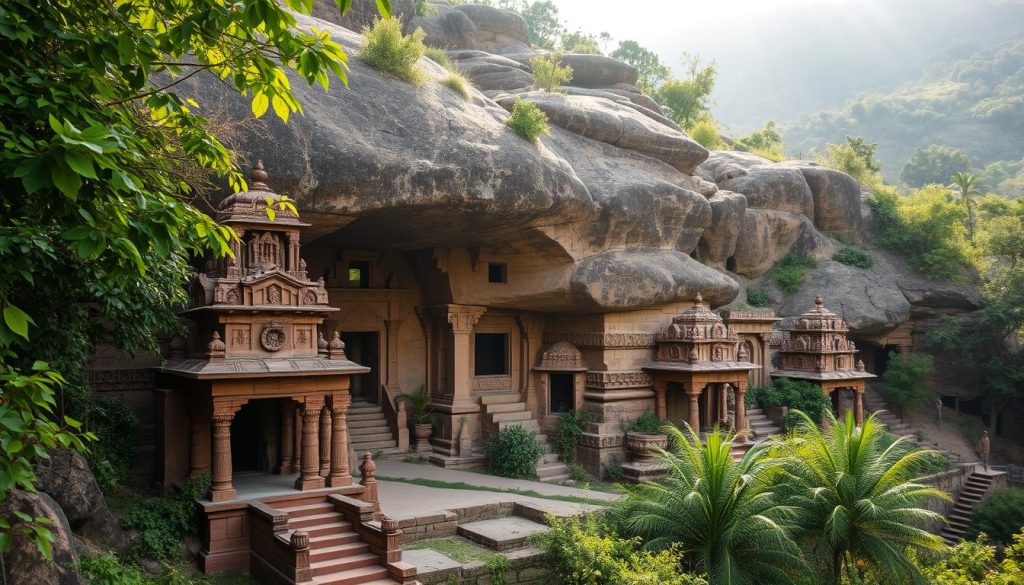
Ajivika Sect and Historical Significance
The Barabar Caves were linked to the Ajivika sect, which is now gone. This group came before Buddhism and Jainism. Emperor Ashoka dedicated caves, like Sudama and Visvakarma, to the Ajivikas around 261 BCE. Inscriptions in the caves tell us about their link to Mauryan rulers. This helps us learn about India’s spiritual past through these ancient Bihar caves.
Architectural Brilliance
The Barabar Caves show amazing skill and artistry. The Lomas Rishi Cave is famous for its detailed work. It looks like wooden buildings from around 260 BCE. These caves started the chaitya arch design. This design later influenced Buddhist caves all over India. Every cave has expertly polished granite. This creates echoes that can last for three minutes.
| Cave Name | Dedication | Notable Features |
|---|---|---|
| Sudama | Emperor Ashoka | Dedicated to the Ajivika sect in 261 BCE |
| Visvakarma | Emperor Ashoka | Frequented by Ajivikas |
| Karan Chaupar | Mauryan rulers | Reflects early Mauryan architecture |
| Lomas Rishi | Historical debate | Chaitya arch, unfinished around 185 BCE |
In conclusion, the Barabar Caves are very important. They show the creativity and faith of the ancient Mauryan period. They are a must-see for anyone exploring Bihar’s temples. These sites help us connect with India’s deep spiritual history.
Kesariya Stupa: A Monument of Magnitude
In Bihar’s town of Kesariya, lies the Kesariya Stupa. It shows the rich history and culture of the area. This huge stupa, which is 104 feet tall, is the biggest Buddha stupa in India. It gives a deep look into the sacred history of Bihar.
Mauryan Empire and Ashoka’s Legacy
The Kesariya Stupa started during the Mauryan Empire, thanks to King Ashoka. Ashoka spread Buddhism across Asia and loved building religious sites. The stupa was made to honor Lord Buddha. It has relics that draw many visitors, being a key part of Bihar’s sacred spots.
Modern-Day Attractions
Now, the Kesariya Stupa is a main spot for lovers of history, archaeology, and spirituality. It has beautiful views and a calm setting. This makes it a great place for thought and discovery. Efforts to make it easy to get to and keep it safe have helped more people visit.
People can also marvel at its ancient architectural style. Plus, some think there might have been a Shiva temple here once. This adds mystery and appeal to Bihar’s holy places.
The Kesariya Stupa is full of insights for those into religious buildings and history. Visiting lets you dive into Bihar’s rich past.
| Aspect | Details |
|---|---|
| Height | 104 feet |
| Historical Period | Mauryan Empire |
| Built By | King Ashoka |
| Significance | Largest Buddha stupa in India |
When talking about hidden temples in Bihar, the Kesariya Stupa is very special. It’s as fascinating as the famous Borobudur in Indonesia. This place makes the experience of exploring Bihar even better.
Bodh Gaya: Less-Known Marvels Beyond Mahabodhi Temple
Bodh Gaya is special because it’s where Buddha found enlightenment. But there’s more than the famous Mahabodhi Temple here. This place is full of Bihar’s mystical temples and traditions. They show the deep spiritual roots of the area.
Ancient Structures and Temples
Although the Mahabodhi Temple is well-known, Bodh Gaya has lots of undiscovered temples. Each ancient building shares a story of faith and history. Look for the detail in carvings, old frescoes, and holy relics. These temples add to the spiritual feel, making Bodh Gaya an experience, not just a place to visit.
Local Beliefs and Traditions
Bodh Gaya’s customs and beliefs offer a deep look at Bihar’s spiritual side. The traditions mix with the temple stories. This brings sacredness to the locals’ everyday lives. When you take part in these traditions, you get to dive deep into the town’s magical feel. This helps you understand Bihar’s mystical temples better.
| Aspect | Highlights |
|---|---|
| Ancient Structures | Numerous lesser-known temples with historical carvings and frescoes |
| Local Traditions | Rich cultural practices interwoven with the temple lore |
| Visitor Experience | Immersive spiritual and cultural engagement |
Kumhrar: The Remnants of Pataliputra
Kumhrar, in Patna, Bihar, shows the beauty of Pataliputra, the old Mauryan Empire capital. This place lets us see into Ancient Bihar. It shows a city key to ancient Indian history. You can see old buildings, big halls, and cool artifacts. They tell us about the architecture and culture back then.
Archaeological Excavations
Archaeologists have found important things at Kumhrar over the years. Early digs from 1912 to 1915 found 72 pillar bases. More digs in 1951 – 55 found eight more pillars. The famous Eighty Pillared Hall had pillars from Uttar Pradesh. They were 32 feet tall and 15 feet apart. This shows the clever city planning of Ancient Bihar.
In Mauryan times, they also built a big canal at Kumhrar. It was 43 feet wide and 10 feet deep. This tells us they had advanced farming methods back then. You can go on tours at Kumhrar Park to learn more about these old structures.
Historical Artifacts and Ruins
We’ve found many cool things and ruins at Kumhrar. Some are from when kings or monks were there. One big find is the Arogya Vihar. It was a hospital-monastery from the Gupta period. It was looked after by the famous doctor Dhanvantari. The building had rooms of different sizes.
Visitors see lots of old things here, like copper coins, jewelry, and toys. These finds show us what life was like in Ancient Bihar. They help us learn about Bihar’s history. Kumhrar Park is open to everyone, including those in wheelchairs. It offers tours and places to eat.
Telhar Kund: Natural Beauty and Sacred Sites
Telhar Kund is in the Kaimur district. It’s known for its beauty and spiritual worth. It’s perfect for finding peace and enjoying nature.
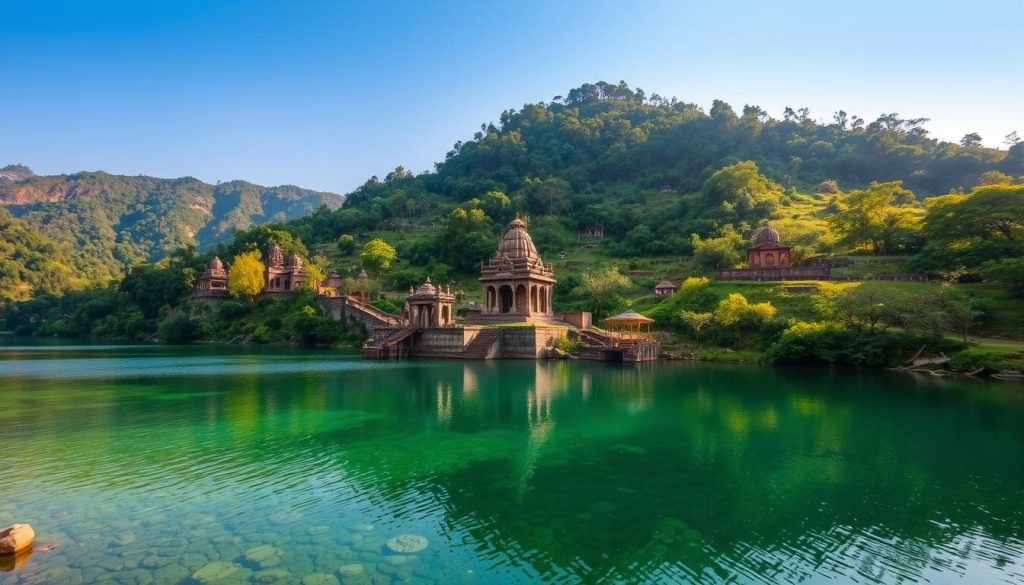
Waterfalls and Trekking Trails
The Telhar Waterfall is stunning. It falls from 80 meters up. It’s a key reason people visit.
The area has beautiful trekking paths too. They offer fun and amazing views.
Religious Significance
Telhar Kund is very sacred in Bihar. Lots of pilgrims come to feel its calm. It’s surrounded by forests, great for quiet thought and meditation.
Telhar Kund is loved for its beauty and holiness. It’s a place for both adventurers and those seeking peace. This puts it at the top of places to see in Bihar.
Conclusion
Bihar is full of old temples, amazing architecture, and deep spiritual meaning. Each hidden temple tells a story of faith and history. The Mahabodhi Temple in Bodh Gaya is very special. It marks where Siddhartha Gautama found enlightenment and became Buddha.
The Vishnupad Temple connects to Lord Vishnu and has unique rituals during Pitra Paksha. This shows Bihar’s big role in Hindu faith. There are also less-known places like the Jalmandir in Pawapuri and the Mandargiri Temple. These sites add to Bihar’s spiritual map.
Pawapuri is peaceful and honors Lord Mahavira. The Mandargiri Temple is known for its beautiful design. From the Jain Jalmandir to the Sikh Patna Sahib Ji, every temple shows a different side of Bihar’s spirituality.
Exploring Bihar’s temples helps us learn about India’s ancient traditions. Famous spots like Mahavir Mandir and quiet places like Dungeshwari Hills are inviting. They welcome those looking for spirituality and history. This guide offers a look into the heart of Bihar’s temple culture. It invites readers to start a journey full of history and deep spiritual stories.
FAQ
What makes the hidden temples in Bihar unique?
The hidden temples in Bihar stand out for their history, spiritual meaning, and beautiful design. They let us peek into ancient beliefs and cultures. This makes the region very special.
How can one explore the hidden temples in Bihar?
One can explore Bihar’s hidden temples through guided tours or by hiring locals. You can also go alone, armed with good research. This journey deep into Bihar’s culture is unforgettable.
What is the historical significance of Sonbhandar Caves?
The Sonbhandar Caves in Rajgir go back to the 3rd or 4th century. Their design comes from the Mauryan times. Inscriptions that may contain secret treasures make it mysterious.
What can visitors expect at Dungeshwari Hills?
At Dungeshwari Hills, visitors find a key spiritual site linked to Lord Buddha. It offers beauty and hikes too. This place draws both peace seekers and adventure lovers.
Why are the Barabar Caves considered important?
The Barabar Caves shine as India’s oldest rock-cut temples. They date from 322-185 BCE. These caves are a peek into past skills and beliefs, making them precious.
What is the Kesariya Stupa known for?
The Kesariya Stupa is India’s tallest Buddha stupa, at 104 feet. It’s a key historical and scenic site. People love it for its history, architecture, and beauty.
What can be found in Bodh Gaya besides the Mahabodhi Temple?
Beside the Mahabodhi Temple, Bodh Gaya has many hidden treasures. It has ancient sites and temples full of spiritual tales. These tell more about local traditions and beliefs.
What does Kumhrar offer to history enthusiasts?
Kumhrar gives history buffs a peek at ancient Pataliputra’s ruins. Here, digs have found old relics like pillars. They remind us of the Mauryan Empire’s splendor.
Why is Telhar Kund a sought-after destination?
Telhar Kund is loved for its beauty and holy meaning. It has a beautiful waterfall and trails perfect for hikes. It’s great for both relaxing and finding peace.





